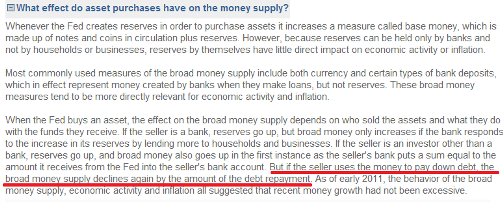[This is further to my previous posts Central Bank LSAP: Is The Money Stock Supply-Determined Or Demand-Determined? and On Effects Of QE.]
Central bank asset purchases or LSAPs increase the stock of money aggregates compared to the counterfactual when there is no QE. Is there an excess of money?
These are two different things.
The notion of “excess money” is usually associated with Monetarism where the supposed “excess” is eliminated by rise in prices of goods and services. Excess money causes prices rise as much to reduce the value of money to reconcile whatever economic agents want to hold so that money demand = money supply where supply is given exogenously.
Which of course is quite wrong.
The reason it is wrong is that while – as argued in the previous posts – QE causes the stock of money to rise, there is no excess because prices and perhaps even quantities in financial markets (which is different from the market for goods and services) adjust so that the stock of money is still demand determined.
Of course that is not to say that the stock of money is the same as the counterfactual – i.e., the stock of money in a QE world is different from what it would have been in the absence of QE. So the stock of money is not exogenously given and adjusts to the demand for money as argued in the previous post and this demand depends on various things such as expected returns on imperfect substitutes – which QE influences.
In the markets for goods and services, there’s hardly an effect because prices are set by producers according to their costs.
Of course there needs to be a few qualifications – in the market for primary products, myths and speculation can lead to a rise in prices – such as the price of oil and this can have inflationary effects but the world we live in is not one in primary products and the original Monetarist idea highlighted at the start of this article is still misleading.
Of course none of this is implies that LSAP/QE has less effect on prices of financial markets – it can indeed cause some unwanted booms.
Another thing is that I mentioned in the previous blog post that supply of money influences demand but doesn’t determine it. Does that mean that the central bank has a “control” on the stock of the money within some limits? Well, not really. Control means influencing whatever is said to be under control to move in the desired direction and this is not always so. For example if the central bank were to behave like what the Bank of England was experimenting in the 70s under Monetarists’ influence, and sell bonds in large quantities in the financial markets, economic units – such as the non-banking sector may expect bond prices to fall and desire to increase their holding of money (as in deposits). This will lead them to sell the bonds to the banking sector which is prepared to buy the bonds acting as dealers in the bond markets. So the outcome may be opposite of the objective with which the central bank started with.

